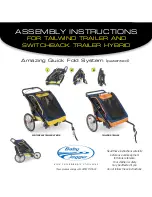
be exhilarating. Do not get so carried away that you forget safety
precautions, traffic laws and common sense – always ride safely and
defensively to enjoy many more rides to come!
2.3
OFF ROAD SAFETY
1
>
Just as in road riding, never underestimate the unpredictability
and risks associated with off-road riding. The variable conditions and
hazards of off-road riding demand close attention and specific skills.
If you are riding off-road for the first time, consider riding with others
with experience or, if available, take an off-road riding course in your
community. Ask your local dealer for information. Regardless, start
slowly and choose a relatively flat and easy terrain to build up your
skills and confidence. Your OHM bicycle comes equipped with front
suspension and seatpost, which will take some time to get used to as
the suspension does soften the ride and may allow you to experience
increased speeds. The increased speed may cause you to lose
control of your bicycle and fall. Get to know how to handle your bike
safely before increasing speeds or advanced terrain.
2
>
Always wear appropriate safety gear required for the type of
riding you are doing (see Sections 2.4 and 2.5). Ask your dealer for
more information.
3
>
Do not perform jumps, stunts or wheelies -- they can cause you
to lose control of your bicycle and result in injury or death and/or
damage to your bicycle.
4
>
Never ride alone when in remote areas. Even if riding with
other people, always ensure someone (e.g., friend, family member,
co-worker) knows where you are and when to expect your return.
5
>
Ensure you ride on trails designated for or permit bicycling. Learn
and obey all laws regulating how and where you can ride off-road.
Always respect private property, which can be difficult to know in
remote areas.
6
>
Be respectful of the rights of other trail users – motorists,
pedestrians, equestrians and other cyclists.
7
>
Yield right of way to pedestrians and animals. Always ride in
a way that does not startle, surprise or endanger them. Stay far
enough away so that their unexpected moves do not endanger you.
Communicate with the person or animal before approaching to alert
them of your presence, to reduce the chance of startling them.
8
>
Always stay on the designated trail and respect the natural
environment. Do not contribute to erosion by riding in mud or with
unnecessary sliding or skidding. Avoid locking the wheels as much
as possible to prevent skidding and additional erosion. Do not
disturb the ecosystem by cutting your own trail or shortcut through
vegetation or streams. It is your responsibility to minimize your
impact on the environment. Always leave the natural environment
as you find it and always take out everything (e.g., food wrappers,
accessories) you brought in.
9
>
BE PREPARED. Ensure you have adequate food/water, appropriate
clothing for a range of weather conditions and essential tools.
T
W
O
>
S
A
F
E
T
Y
14
Summary of Contents for bicycle
Page 49: ...ohmcycles com...













































